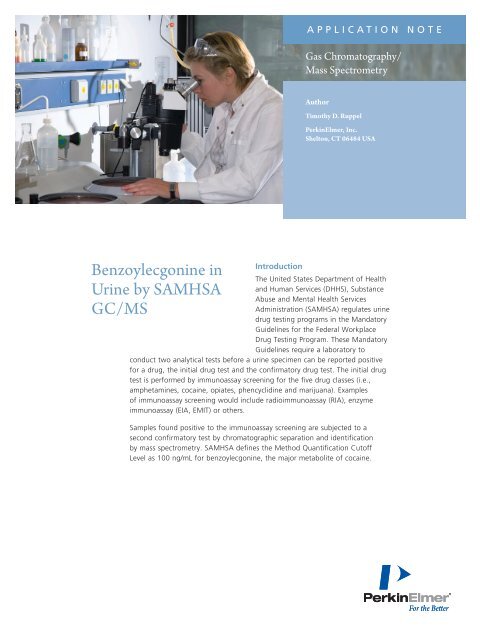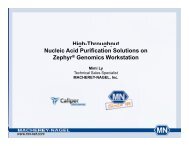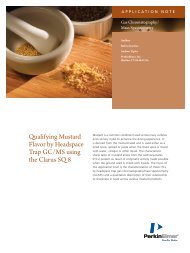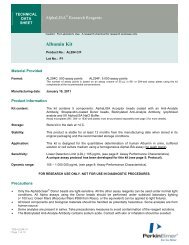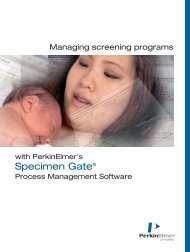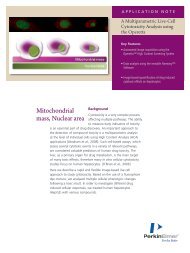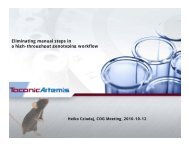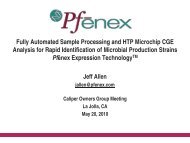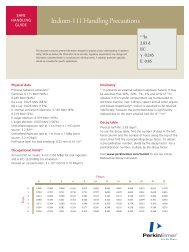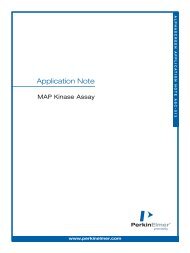Benzoylecgonine in Urine by SAMHSA GC/MS - PerkinElmer
Benzoylecgonine in Urine by SAMHSA GC/MS - PerkinElmer
Benzoylecgonine in Urine by SAMHSA GC/MS - PerkinElmer
You also want an ePaper? Increase the reach of your titles
YUMPU automatically turns print PDFs into web optimized ePapers that Google loves.
application Note<br />
Gas Chromatography/<br />
Mass Spectrometry<br />
Author<br />
Timothy D. Ruppel<br />
Perk<strong>in</strong>Elmer, Inc.<br />
Shelton, CT 06484 USA<br />
<strong>Benzoylecgon<strong>in</strong>e</strong> <strong>in</strong><br />
Ur<strong>in</strong>e <strong>by</strong> <strong>SAMHSA</strong><br />
<strong>GC</strong>/<strong>MS</strong><br />
Introduction<br />
The United States Department of Health<br />
and Human Services (DHHS), Substance<br />
Abuse and Mental Health Services<br />
Adm<strong>in</strong>istration (<strong>SAMHSA</strong>) regulates ur<strong>in</strong>e<br />
drug test<strong>in</strong>g programs <strong>in</strong> the Mandatory<br />
Guidel<strong>in</strong>es for the Federal Workplace<br />
Drug Test<strong>in</strong>g Program. These Mandatory<br />
Guidel<strong>in</strong>es require a laboratory to<br />
conduct two analytical tests before a ur<strong>in</strong>e specimen can be reported positive<br />
for a drug, the <strong>in</strong>itial drug test and the confirmatory drug test. The <strong>in</strong>itial drug<br />
test is performed <strong>by</strong> immunoassay screen<strong>in</strong>g for the five drug classes (i.e.,<br />
amphetam<strong>in</strong>es, coca<strong>in</strong>e, opiates, phencyclid<strong>in</strong>e and marijuana). Examples<br />
of immunoassay screen<strong>in</strong>g would <strong>in</strong>clude radioimmunoassay (RIA), enzyme<br />
immunoassay (EIA, EMIT) or others.<br />
Samples found positive to the immunoassay screen<strong>in</strong>g are subjected to a<br />
second confirmatory test <strong>by</strong> chromatographic separation and identification<br />
<strong>by</strong> mass spectrometry. <strong>SAMHSA</strong> def<strong>in</strong>es the Method Quantification Cutoff<br />
Level as 100 ng/mL for benzoylecgon<strong>in</strong>e, the major metabolite of coca<strong>in</strong>e.
Overview<br />
The general procedure for the drug confirmatory test <strong>in</strong><br />
ur<strong>in</strong>e follows the 7 steps listed below:<br />
1. Add a deuterated <strong>in</strong>ternal standard to the ur<strong>in</strong>e.<br />
2. Adjust ur<strong>in</strong>e pH.<br />
3. Hydrolyze ur<strong>in</strong>e (opiates and cannab<strong>in</strong>oids only).<br />
4. Extract drugs from ur<strong>in</strong>e us<strong>in</strong>g solid phase extraction<br />
(SFE), evaporate to dryness.<br />
5. Derivitize the extract (except for PCP), evaporate to dryness.<br />
6. Reconstitute extract <strong>in</strong>to organic solvent.<br />
7. Inject 1-3 µL <strong>in</strong>to gas chromatograph/mass spectrometer<br />
for identification and quantification us<strong>in</strong>g 3 ion ratio<br />
report.<br />
Glassware<br />
All glassware, <strong>in</strong>clud<strong>in</strong>g autosampler vials and low volume<br />
vial <strong>in</strong>serts must be silanized to prevent adsorption of sample.<br />
Soak all glassware <strong>in</strong> 10% DMDCS/Toluene for 10 m<strong>in</strong>.<br />
R<strong>in</strong>se <strong>in</strong> methanol, r<strong>in</strong>se <strong>in</strong> hexane, air dry.<br />
Reagents List<br />
Acetic Acid, 100 mM = 2.86 mL glacial acetic acid diluted to<br />
500 mL DI water.<br />
Phosphate buffer, 100 mM pH6 = 1.7 g Na 2HPO 4 + 12.14 g<br />
Na 2HPO 4 dilute to 1000 mL with DI water, adjust to pH6<br />
with 100 mM Na 2HPO 4 (raises pH) or 100 mM Na 2HPO 4<br />
(lowers pH).<br />
Methylene Chloride/Isopropanol/Ammonium Hydroxide<br />
(78:20:2) extraction solvent = 40 mL IP-OH + 4 mL con<br />
NH 4OH + 156 mL MeCl 2. Make fresh daily.<br />
Drug standards and deuterarated <strong>in</strong>ternal standards are<br />
available from Cerillant (Round Rock, TX). Internal standard:<br />
d3-BE.<br />
Instrumentation<br />
Gas Chromatograph: Perk<strong>in</strong>Elmer ® Clarus ® 680 <strong>GC</strong>.<br />
Injector: Capillary <strong>in</strong>jector us<strong>in</strong>g pressure pulsed splitless<br />
<strong>in</strong>jection, 250 °C.<br />
Injection port l<strong>in</strong>er: Siltek with wool (Cat. No. N6502010).<br />
<strong>GC</strong> Column: Elite-5 (5% Phenyl/95% Methyl Silicone) – 12<br />
m x .200 mm x 0.33 µm (Cat. No. N9316110). Helium carrier<br />
– 2 mL/m<strong>in</strong>.<br />
<strong>GC</strong> oven: Start temperature 100 °C. Hold for 0.5 m<strong>in</strong>, then<br />
20 °C/m<strong>in</strong> to 310 °C. Hold 4 m<strong>in</strong>.<br />
Pressure pulsed, splitless <strong>in</strong>jection: This procedure raises the<br />
<strong>in</strong>jector pressure dur<strong>in</strong>g the <strong>in</strong>jection process to put more<br />
sample onto the column <strong>in</strong> a narrow band and then reduces<br />
the carrier gas to normal operational l<strong>in</strong>ear gas velocity for<br />
chromatography. This is accomplished with timed events such<br />
as the follow<strong>in</strong>g:<br />
CAR2 set to 5 mL/m<strong>in</strong> at -0.71 m<strong>in</strong> (raise pressure before<br />
<strong>in</strong>jection).<br />
SPL2 set to 0 at -0.70 m<strong>in</strong> (splitless <strong>in</strong>jection).<br />
CAR2 set to 2 mL/m<strong>in</strong> at 0.7 m<strong>in</strong> (operat<strong>in</strong>g flow after <strong>in</strong>jection).<br />
SPL2 set to 50 at 0.8 m<strong>in</strong> (open split vent after <strong>in</strong>jection).<br />
Mass Spectrometer: Perk<strong>in</strong>Elmer Clarus SQ 8 <strong>MS</strong>, 255 L/sec<br />
turbomolecular pump, EI mode.<br />
All data is collected <strong>in</strong> selected ion monitor<strong>in</strong>g mode (SIM)<br />
acquir<strong>in</strong>g 20-50 msec per ion.<br />
A primary ion is used for identification and quantitation<br />
while 2 additional ions are used for confirmation of<br />
identification.<br />
Three ion ratio chromatograms must all apex with<strong>in</strong> ±2<br />
scans of standard retention time. Ion ratios must fall with<strong>in</strong><br />
±20% of standard ratios. Deuterated <strong>in</strong>ternal standards may<br />
use only 2 ions, a primary ion and only 1 confirmation ion.<br />
PFPA SIM ions:<br />
BE: 300,421,316 d3-BE: 303,424 RT: 5.17 m<strong>in</strong><br />
BSTFA SIM Ions:<br />
BE: 240,361,256 d3-BE: 243,364 RT: 4.76 m<strong>in</strong><br />
Solid Phase Extraction<br />
Drugs are extracted from the ur<strong>in</strong>e sample matrix <strong>by</strong> solid<br />
phase extraction (SPE) with a polymeric res<strong>in</strong> cartridge. The<br />
drugs are reta<strong>in</strong>ed as the ur<strong>in</strong>e is passed through the res<strong>in</strong><br />
bed. Wash<strong>in</strong>g the bed can remove salts and other contam<strong>in</strong>ants.<br />
Elut<strong>in</strong>g the drugs off the res<strong>in</strong> bed with a stronger solvent<br />
completes the cleanup process from the ur<strong>in</strong>e. Extraction<br />
cartridges used were Supra-Clean SPE Columns C18-S 200 mg/<br />
3 mL 50 u (Cat. No. N9306462).<br />
2
Experimental<br />
Extraction Procedure: 1-2 mL ur<strong>in</strong>e + ISTD + 2 mL 100 mM phosphate<br />
buffer (pH 6). SPE column extract: Condition column with 3 mL methanol,<br />
then 3 mL DI water, then 1 mL 100mM phosphate buffer (pH6). Extract<br />
sample, wash column with 3 mL DI water, then 1 mL 100 mM HCl,<br />
then 1 mL methanol. Elute column with 3 mL Methylene chloride:<br />
Isopropanol:Ammonium Hydroxide (78:20:2) <strong>in</strong>to conical tube.<br />
Evaporate to dryness
Alternative derivitization us<strong>in</strong>g BSTFA.<br />
Experimental<br />
Extraction Procedure: 1-2 mL ur<strong>in</strong>e + ISTD + 2 mL 100 mM phosphate buffer<br />
(pH 6). SPE column extract: Condition column with 3 mL methanol, then 3 mL DI<br />
water, then 1 mL 100 mM phosphate buffer (pH6). Extract sample, wash column<br />
with 3 mL DI water, then 1 mL 100 mM HCl, then 1 mL methanol. Elute column<br />
with 3 mL Methylene chloride:Isopropanol:Ammonium Hydroxide (78:20:2) <strong>in</strong>to<br />
conical tube. Evaporate to dryness
Limit of Quantitation: 10 ng/mL from 1 mL ur<strong>in</strong>e<br />
Limit of Detection: < 2 ng/mL from 1 mL ur<strong>in</strong>e<br />
L<strong>in</strong>ear Correlation coefficient (R2) >0.999 10 ng/mL –<br />
1000 ng/mL<br />
Conclusions<br />
This application has presented the analysis of benzoylecgon<strong>in</strong>e<br />
<strong>in</strong> ur<strong>in</strong>e for the test<strong>in</strong>g requirements of the Federal<br />
Workplace Drug Test<strong>in</strong>g Program. Forensic and cl<strong>in</strong>ical laboratories<br />
can use the same method for toxicology samples<br />
<strong>in</strong> non-regulated drug test<strong>in</strong>g. Fast sample throughput was<br />
<strong>in</strong>creased through the use of a short <strong>GC</strong> column, fast flow<br />
rate <strong>in</strong>to the mass spectrometer, very fast cool<strong>in</strong>g <strong>GC</strong> oven<br />
and autosampler pre-r<strong>in</strong>s<strong>in</strong>g options.<br />
References<br />
1. Disposition of Toxic Drugs and Chemicals <strong>in</strong> Man, 8th Ed,<br />
Randall C. Baselt, Biomedical Publications, 2008.<br />
2. Mandatory Guidel<strong>in</strong>es for Federal Workplace Drug Test<strong>in</strong>g<br />
Programs, Fed Reg, 73: 71857 (Nov. 25, 2008).<br />
3. Mandatory Guidel<strong>in</strong>es for Federal Workplace Drug Test<strong>in</strong>g<br />
Programs, 75 Fed Reg, 75: 22809 (April 30, 2010).<br />
4. Pierce Catalog (Rockford, IL).<br />
The Perk<strong>in</strong>Elmer Clarus SQ 8 <strong>GC</strong>/<strong>MS</strong> system operat<strong>in</strong>g <strong>in</strong> SIM<br />
mode provided the sensitivity and spectral data necessary to<br />
generate legally defensible results. The TurboMass <strong>GC</strong>/<strong>MS</strong><br />
software <strong>in</strong>cludes 3-ion ratio confirmation calculations and<br />
report<strong>in</strong>g to present data <strong>in</strong> a format that is simple and easy<br />
to understand.<br />
Perk<strong>in</strong>Elmer, Inc.<br />
940 W<strong>in</strong>ter Street<br />
Waltham, MA 02451 USA<br />
P: (800) 762-4000 or<br />
(+1) 203-925-4602<br />
www.perk<strong>in</strong>elmer.com<br />
For a complete list<strong>in</strong>g of our global offices, visit www.perk<strong>in</strong>elmer.com/ContactUs<br />
Copyright ©2011, Perk<strong>in</strong>Elmer, Inc. All rights reserved. Perk<strong>in</strong>Elmer ® is a registered trademark of Perk<strong>in</strong>Elmer, Inc. All other trademarks are the property of their respective owners.<br />
008424C_01


